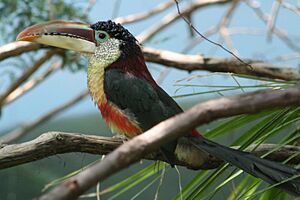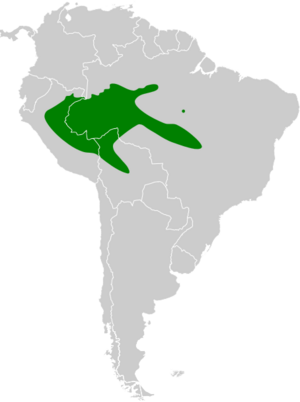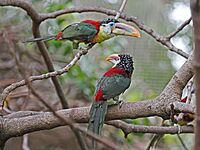Curl-crested aracari facts for kids
Quick facts for kids Curl-crested aracari |
|
|---|---|
 |
|
| At Riverbanks Zoo, US | |
| Conservation status | |
| Scientific classification | |
| Genus: |
Pteroglossus
|
| Species: |
beauharnaisii
|
 |
|
| Synonyms | |
|
|
The curl-crested aracari (Pteroglossus beauharnaisii) is a cool bird from the toucan family. It lives in the forests of Bolivia, Brazil, and Peru. This bird gets its name from the unique, shiny, curly feathers on its head!
Contents
About the Curl-Crested Aracari
Scientists first described the curl-crested aracari in 1831. Its scientific name, Pteroglossus beauharnaisii, has been adjusted over time to make sure it's spelled correctly. This bird is the only one of its kind, meaning it doesn't have different subspecies.
What Does It Look Like?
The curl-crested aracari is about 42 to 46 centimeters (16.5 to 18 inches) long. It weighs between 164 and 280 grams (5.8 to 9.9 ounces). The most amazing thing about it is the curly, black feathers on its head. They look like shiny pieces of plastic or enamel!
Both male and female aracaris look similar. However, the female has a slightly shorter beak. Their beaks are very colorful. The lower part of the beak is ivory, turning orange at the tip. The upper part has an orange top edge and a maroon stripe along the bottom. The middle part of the upper beak is green or bluish. They also have small, ivory-colored "teeth" along the edges of their beak.
Around their eyes, they have bare blue skin. Their cheeks and throat are whitish with small black spots. The upper part of their back and their rump are red. The rest of their upper body is a dark green. Their belly is yellow with a wide red band across the lower chest. Young aracaris look like adults but have duller colors.
Where Do They Live?
The curl-crested aracari lives in the southwestern Amazon Basin, south of the Amazon River. You can find them from northern Peru, east into western Brazil, and south into northern and central Bolivia.
They like to live inside wet forests, including both well-drained areas and swampy ones. They also hang out in forest clearings and along the edges. Most of the time, they live in areas below 500 meters (1,600 feet) in elevation. But sometimes, they can be found as high as 900 meters (3,000 feet) near the Andes mountains.
How Do They Behave?
Moving Around
Curl-crested aracaris seem to stay in their home areas for most of the year. They might make short trips nearby, but they don't migrate long distances.
What Do They Eat?
These birds usually look for food in groups of up to 12 individuals. They often search for food high up in the trees, in the canopy. However, they also eat from fruiting bushes closer to the ground. Their main food is fruit.
Interestingly, they are also known to eat the eggs and young chicks of other birds. They will even tear apart the nests of birds like the yellow-rumped cacique to get them!
Raising Their Young
The breeding season for the curl-crested aracari seems to be mostly from May to August. However, it might start earlier or last longer. Scientists don't know much about their nests, eggs, or how they raise their young yet.
What Sounds Do They Make?
The curl-crested aracari makes several different calls. These include deep "rrek" notes and soft "rrr" sounds. They also make hard, grunting "grenk" notes. When they are settling down to sleep, they make a softer "et-et" sound. Some people have also heard them make a low, rough "cha-cha-cha cha wruh cha--" sound.
Are They Safe?
The IUCN (International Union for Conservation of Nature) says the curl-crested aracari is a species of "Least Concern." This means they are not currently in danger of disappearing. They live across a large area, but their exact population size isn't known. Scientists believe their numbers might be slowly going down.
There aren't any big, immediate threats to them right now. They live in protected areas like the Tambopata National Reserve in Peru. People do hunt them sometimes. More research is needed to learn about these birds. This way, we can make sure they stay safe in the future if they ever need protection.
Gallery
-
Illustration by John Gould and Henry Constantine Richter
-
At San Diego Zoo, US





